Challenging, demanding, exciting—all those words describe the sport of eventing. Here’s another: risky. Injuries and soundness problems plague horses in every discipline, but event horses face bigger risks for specific types of problems.
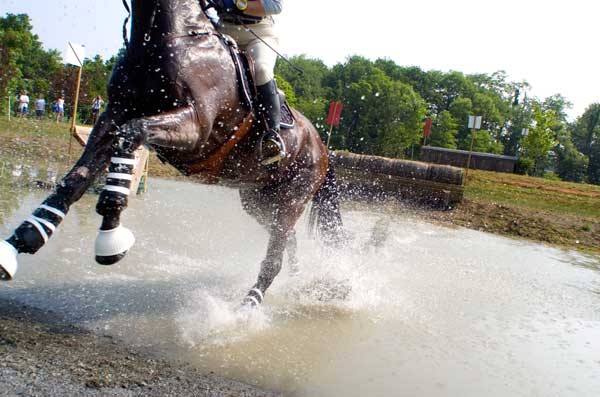
In this article Kevin Keane, DVM, explains why and how these problems can affect your horse and what you can do to keep them from ending his career. Dr. Keane knows the hazards first-hand. A three-day rider himself, he heads a sporthorse practice in Cochranville, Pennsylvania, and is the treating veterinarian for Phillip Dutton, Boyd Martin and other top competitors.
What Makes Eventing Risky?
Half a dozen factors may increase the chances of soundness problems for horses in the sport, Dr. Keane says.
Speed: “Eventing is a galloping discipline like racing, polo and foxhunting. Speed increases the risk of soft-tissue injuries,” he says, particularly tendon and ligament injuries.
Jumps: They’re immovable, so traumatic injuries occur from hits and falls.
Footing: “Horses in most disciplines today compete on all-weather, prepared footing, but that’s not the case in eventing,” says Dr. Keane. Event horses gallop for 5 to 12 minutes (depending on the competition level) over natural terrain that may be hard, deep, slick or uneven. “The terrain increases the risk of missteps and injuries,” he says.
Past use: Traditionally, many ex-racehorses have competed in eventing. These horses did hard work as 2- and 3-year-olds, Dr. Keane says, and that may predispose them to soundness problems later in life. “This may be less a factor now because there are more purpose-bred horses in the sport but still a concern for many horses,” he adds.
Longer seasons: “Twenty years ago most event horses had the winter off, which gave them time to rest and recover from physical stress and injuries. They’d finish in the fall and not compete again until late March,” he says. “Now the center of the sport has moved south, with many trainers setting up winter or year-round quarters in the Carolinas or Florida, and the competition schedule has expanded to start earlier. Horses need to start training for the season much sooner, and the rest period is shorter.”
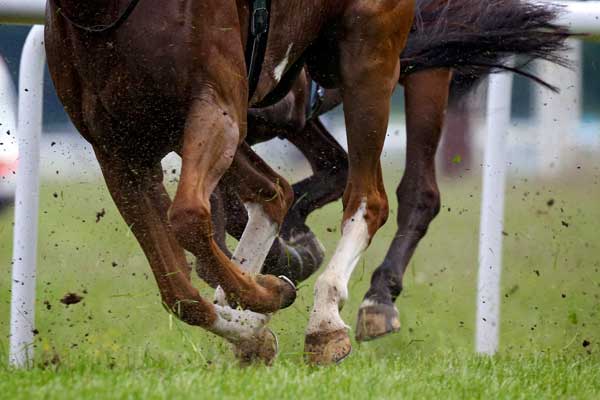
More competitions: Today a horse may have to complete three or four lower-level events to qualify for a national horse trial or three-day. Stringent qualification requirements help ensure that horses (and riders) aren’t overfaced in a sport where a slight miscalculation cross country can be catastrophic. But, Dr. Keane notes, “The horse is exposed to a level of risk every time he competes.”
Luck is a factor, too—a bad step or an awkward landing is always possible. Together, these factors increase the odds of sudden injuries as well as chronic conditions that develop through wear and tear.
Soft-Tissue Trouble
The biggest risks are to the tendons and ligaments behind the cannon bone, tough fibrous cords that link muscle to bone (tendons) and bone to bone (ligaments). At the back of the leg, just under the skin, is the superficial digital flexor tendon. Just under the SDFT is the deep digital flexor tendon; below that, the check ligament; and the suspensory ligament lies closest to the bone. “In event horses we see these injuries most often in the forelimb, in the superficial digital flexor tendon and the suspensory ligament,” Dr. Keane says. “They occur somewhat less often in the deep digital flexor tendon and the check ligament.” Tendons and ligaments are injured in the hind limbs, too, but less commonly in event horses.
Why and how: “The tendons primarily provide elasticity to the limb. Their elastic nature allows them to absorb shock on impact, store energy and then release it when the limb leaves the ground,” he says. They also work with the ligaments to support the ankle joint as it sinks under weight. Speed and jumping increase the load on the forelimbs and, with that, the risk that a tendon or ligament will tear under the strain. A mild injury may result in tearing in just a few fibers, but repeated stress will make it worse. A severe injury can rupture the tendon or ligament; the suspensory ligament may even fracture bone as it tears away.
What you see: Lameness ranges from severe to barely noticeable, depending on how bad the damage is. The leg may be warm, sensitive and swollen at the site. Swelling in an injured SDFT produces the classic “bowed” appearance. But heat, swelling and sensitivity are hard to detect when the injury is high in the suspensory ligament because that area is hidden by other structures.
What to do: If you suspect a soft-tissue injury, even a mild one, have your veterinarian examine the horse. “With ultrasound we can assess these injuries earlier and more accurately and rate them as mild, moderate or severe, based on the amount of damage to the tissue,” Dr. Keane says. Every soft-tissue injury is different, and your veterinarian will help you work out a treatment plan that suits your horse’s case. Generally, the plan will follow these steps:
- cool-down period to reduce inflammation. Your vet may prescribe cold therapy (icing or cold-hosing several times a day) and a nonsteroidal anti-inflammatory drug, such as phenylbutazone or Banamine (flunixin meglumine).
- stall rest to give torn fibers time to heal. Your vet may advise standing wraps for the injured leg and the opposing leg.
- hand-walking to encourage healing. Follow your vet’s advice, starting with as little as 10 minutes a day and gradually increasing the time.
- gradual return to work. Your vet will help you set up a program that eases your horse back into work over several months, making sure that exercise increases only if the horse is sound and ultrasound shows healing is proceeding.
“The horse needs a tailored program of progressive exercise, monitored with repeat ultrasound and physical exams. There’s a lower risk of recurrence with this type of monitored program, as opposed to estimating when the horse can return to work,” Dr. Keane says. “The goal is to get the best level of healing possible. On ultrasound you want to see gaps or tears filling in with tendon or ligament fibers aligned in a linear pattern, along with a reduction in size [swelling].”
Depending on the case, your vet may suggest other therapies, he adds. “Regenerative therapies—injections of PRP or stem cells—are the newest technique to encourage healing.” PRP is plasma (the straw-colored liquid portion of blood) with high concentrations of platelets, blood cells that release growth factors that spur healing. This and other regenerative treatments are thought to help the tissues heal stronger, but they don’t shorten the layup and rehab time. “The jury is still out on the long-term benefits of these techniques, but we’re using PRP with encouraging results,” Dr. Keane says.
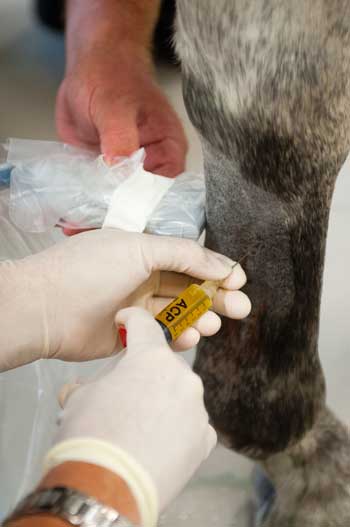
Outlook: Tendons and ligaments heal slowly and sometimes imperfectly. “For a mild injury, perhaps just some inflammation in a tendon, the outlook is good. The horse may return to work in several months. More-severe lesions may take anywhere from six to 18 months to heal, and the chance of reinjury is greater,” says Dr. Keane. “The location of the injury makes a difference in the outlook, too. Injuries in the midsection of the SDFT or the suspensory tend to heal more easily than those in the upper or lower ends.” Keep in mind that the horse may trot sound long before the damage is healed, and rushing him back to work is likely to cause a setback.
Hard Knocks
Impact injuries—bruising and more-serious trauma—are common in cross-country competition. Hard ground and solid obstacles are the main causes, and stifle joints and feet are prime sites.
How and why: In one common scenario, the horse hits or scrapes his stifle on the top of a fence. The damage may be superficial, but there’s not much padding over the joint. “A direct hit can sometimes fracture the patella [kneecap]. The horse may continue and complete the course before the injury is found,” Dr. Keane says. Other joints—knees, fetlocks—can be injured in similar fashion.
Galloping and jumping on hard ground can bruise the soft tissues between the sole and the bones of the foot, especially in horses with thin-walled feet. Or the horse may lose a shoe on course; unless the loss affects his way of going and causes the rider to pull up, he finishes the course without it. That can lead to extensive bruising.
What you see: At the stifle or other impact sites you’ll find heat and swelling (caused by blood and other fluids collecting beneath the skin), and the area will be extremely sensitive to touch. There may be cuts and scrapes, too. Whether the horse is lame depends on how severe the damage is.
Bruising causes internal bleeding and swelling in the foot, too. Here the fluid builds up within the hoof capsule, creating pressure and pain. Your horse will be sore, and there may be heat in the foot, but you may see no external sign until weeks later, when a reddish stain appears on the sole. The bruising can be extensive and deep enough to damage cartilage and bone.
What to do: Call the vet for
- wounds that penetrate through the skin (so that the skin gaps when you gently pull the edges), which may need sutures.
- deep punctures, which should be flushed, or embedded splinters, which should be removed.
- lameness that is severe or lasts for more than a few days. The vet can pinpoint the sore zone and take X-rays to rule out a fracture.
Minor soft-tissue injuries and sole bruises are things you can probably handle on your own.
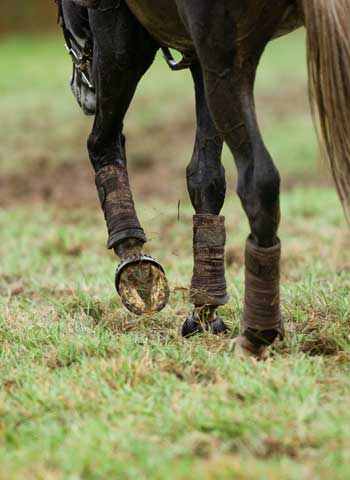
- Cold therapy helps soft-tissue bruises in the initial stages by minimizing swelling. Cold-hose for 20 minutes at a time, several times a day, just for the first day or so.
- Clean superficial wounds with sterile saline solution, a topical such as Betadine, or a gentle stream of water from a hose. If the wound won’t be sutured, apply triple antibiotic ointment. (Ideally you’d apply a sterile bandage, too, but at the stifle that’s not possible.)
- Soak and poultice sole bruises to help draw excess fluid from the injury. Soak the foot in warm water and Epsom salts for 10 to 15 minutes once or twice a day for three or four days, and follow the soak with a poultice.
The horse should rest until soreness and swelling are gone.
Outlook: These injuries usually heal completely, Dr. Keane says. Mild soft-tissue bruises may clear up in a matter of days. A fractured patella can often be surgically repaired. Deep bruising in the foot may sideline the horse for weeks or months, depending on the degree of the injury, but given time it will heal. Good shoeing (sometimes with pads) and good footing can help prevent reinjury.
Sore Joints
Degenerative joint disease occurs across disciplines, especially as horses age, but the stresses of eventing increase the risks. “DJD can develop in any joint, even in the joints of the back or neck,” Dr. Keane says, “but in event horses we see it most often in the stifle and hock in the hind limb and the fetlock and coffin joint in the forelimb.”
These joints are built for action. Smooth cartilage covers bone surfaces where they meet, so the surfaces slide across each other without friction. A fibrous capsule encloses the joint, and its lining secretes synovial fluid—a thick, viscous substance that lubricates the joint like motor oil. But excessive stress on these joint can set off a destructive chain of events.
How and why: DJD can follow a severe joint injury such as a chip fracture or a dislocation, but cumulative wear and tear can also trigger this problem. It begins with inflammation in the joint capsule or synovial lining. That causes the synovial fluid to turn watery, so it doesn’t lubricate the joint so well. The cartilage is squeezed and inflammatory mediators (proteins the body releases as part of inflammation) begin to damage it. Over time the cartilage breaks down, leaving bone surfaces less protected. Lumpy, new bone growth may appear where bone tissue is irritated.
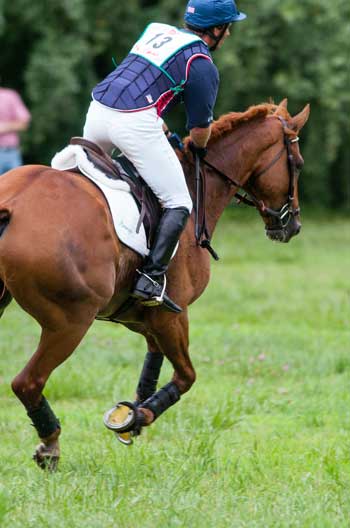
What you see: Heat, pain and swelling are the signs of inflammation, and if your horse has a severe joint injury or advanced DJD you’ll probably have no trouble spotting them. But DJD can creep up gradually, and early signs may be subtle. The horse may have a mild on-and-off lameness. He may just seem less fluid or less forward in his gaits or start work stiff and then work out of it. He may resist certain maneuvers, such as turning or going downhill. Over time, the problem increases.
Your veterinarian can do a full lameness exam and perform a range of tests to see what’s going on. Early detection and treatment will give you the best shot at managing this condition.
What to do: The goal is to control inflammation and reduce its destructive effects. Rest and a short course of an NSAID can help short-term, but inflammation is likely to flare up when the horse goes back to work. If the horse has a chip fracture in the joint, he may need surgery to remove the chip. But for most horses there are three main approaches to limiting long-term damage, Dr. Keane says.
- Corticosteroids (which are powerful anti-inflammatories) and hyaluronic acid (a natural component of joint fluid that makes the fluid viscous) can be injected into the joint capsule to reduce inflammation and help protect cartilage. “Repeated injections with some corticosteroids can be harmful to cartilage long-term, especially in high-motion joints, but the forms used for these injections are less so,” Dr. Keane notes. Any injection carries some risk of allergic reaction or infection, he adds, but care in preparation makes the risk minimal.
- Systemic medications such as Adequan® IM and Legend® IV work in similar ways to block effects of inflammation in joints. They’re given at intervals ranging from weekly to monthly, on an ongoing basis. Adequan contains polysulfated glycosaminoglycan, a component of cartilage. Legend contains a form of HA.
- Autologous treatments use substances derived from the horse’s blood, like PRP. A substance widely used in joints, especially those that do not respond to other treatments, is interleukin-1receptor antagonist protein. It targets a specific inflammatory mediator (interleukin-1) involved in cartilage erosion. Concentrated and injected into the joint capsule, IRAP can keep this mediator from latching onto cartilage cells. Treatment usually involves a series of three to five weekly shots.
“In many cases these approaches are used in combination,” Dr. Keane says. There are also many oral joint supplements—but since supplement makers (unlike drug manufacturers) don’t have to run clinical trials to show the effectiveness of their products, there’s little research to show which are helpful.
Outlook: Because DJD tends to worsen over time, it can limit a horse’s career. So far no one has found a way to reverse its effects, but the box of tools for fighting it is growing. Your horse will have the best chance of continuing his career if you start the fight early.
Beat the Odds
You can never rule out the chance of a misstep, but you don’t need to leave your horse’s future soundness entirely up to luck. Here are five things you can do now to increase his odds of staying in the game:
Build fitness. Make sure your horse is conditioned for the demands he’ll face in competition. If he’s not, he’ll tire quickly—and fatigue increases the risk of missteps and injuries. (A recent Dutch study found a clear link between fitness levels and injury risks in event horses; read about it in Practical Horseman’s Health Update column, December 2013.) Increase work levels gradually.
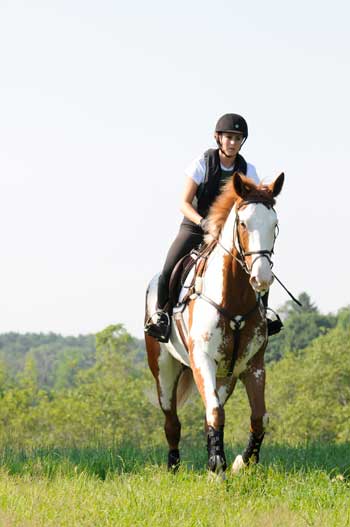
Get top foot care. “Foot balance is critical in preventing injuries. Knowledgeable farriers and advanced shoeing techniques can reduce risks,” says Dr. Keane.
Ride smart. “When the footing isn’t great, the rider needs to decide if it’s prudent to go fast on cross country. Do you take the risk or not? Winning in this sport requires speed, but it’s not always necessary to go for the win,” Dr. Keane says. Many four-star riders hold back at prep events, he notes, saving their horses for the big competitions that count.
Schedule breaks. Space out demanding training sessions and competitions to give him time to recover in between.
Be proactive. Stay tuned in to your horse, so you can recognize subtle, early signs of physical problems. Is he moving with shorter strides or beginning to have trouble with lead changes in one direction or the other? Is he consistently grumpy and resistant in training sessions?
“Catching injuries early is important—a mild tendon strain can become a major tear if the horse keeps working on it,” Dr Keane says. “Frequent evaluations—jogging to detect mild lameness, palpation to detect heat, sensitivity and swelling—are critical. You want to back off at the first hint of trouble.”
This article originally appeared in the May 2014 issue of Practical Horseman.












